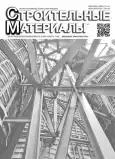The history of cement development — from ancient times to modern innovations
- Authors: Strzhalkovskaya N.V.1, Romanova Y.I.1
-
Affiliations:
- CEMROS JSC
- Issue: No 7 (2025)
- Pages: 38-43
- Section: Статьи
- URL: https://rjsvd.com/0585-430X/article/view/688696
- DOI: https://doi.org/10.31659/0585-430X-2025-837-7-38-43
- ID: 688696
Cite item
Abstract
Retrospective of the building materials (namely cement) development from the 17th century to the present is presented. On October 21, 1824, D. Aspdin patented Portland cement – this date is considered to be the “birthday” of the modern cement. However, the composition and properties of that binder seriously differed from present. 200 years of research and testing, optimal components ratio studying, firing temperatur control, continuous improvement of cement production technologies and methods allows us to create more complex and durable structures. Russian scientists V.M. Severgin, E.G.Chelishchev, N.N. Lyamin, A.A. Baykov and others made a significant contribution to the cement development and its properties study. Currently, the Russian cement industry is a dynamically developing sector that is completely privately owned. There are more than 58 cement plants operating in the RF, which provide the domestic market with building materials and participate in export supplies.
Keywords
Full Text
About the authors
N. V. Strzhalkovskaya
CEMROS JSC
Email: info@cemros.ru
Candidate of Siences (Engineering), Head of the Technical Marketing Department
Russian Federation, build. 34, 29, Vereiskaya Str., Moscow, 121357Yu. I. Romanova
CEMROS JSC
Author for correspondence.
Email: info@cemros.ru
Online Communications Editor
Russian Federation, build. 34, 29, Vereiskaya Str., Moscow, 121357References
- Rakhimov R.Z. Gypsum in construction from ancient centuries to the present. Academia. Arkhitektura i Stroitel’stvo. 2021. No. 4, pp. 120–124. (In Russian). EDN: IPJJFV. https://doi.org/10.22337/2077-9038-2021-4-120-124
- Elsen Ja., Jackson M.D., Ruiz-Agudo E. Historic concrete science: opus caementicium to “natural cements”. Elements: an International Magazine of Mineralogy, Geochemistry, and Petrology. 2022. Vol. 18. No. 5, pp. 301–307. EDN: BZLGXJ. https://doi.org/10.2138/gselements.18.5.301
- Polyakov E.N., Evlakhov E.A. Roman pantheon – “Temple of all gods”. Vestnik of Tomsk State University of Architecture and Civil Engineering. 2012. No. 3 (36), pp. 9–26. (In Russian). EDN: PCQOOD
- Robert G. Blezard. Lea’s Chemistry of Cement and Concrete (Fourth Edition). The History of Calcareous Cements. 1998, pp. 1–23. https://doi.org/10.1016/B978-075066256-7/50013-8
- Nikolay Nikolaevich Lyamin. Stroitel’nye Materialy: Nauka [Construction Materials: Science]. 2009. No. 3, pp. 94–96. (In Russian). EDN: KMKQRT. http://rifsm.ru/u/f/sm_03-09-finish.pdf
- Alexander Alexandrovich Baykov. Stroitel’nye Materialy: Nauka [Construction Materials: Science]. 2010. No. 3, pp. 106–109. (In Russian). EDN: MSTUBJ. http://rifsm.ru/u/f/sm_03_10_finish.pdf
- Ivan Grigorievich Malyuga. Stroitel’nye Materialy: Nauka [Construction Materials: Science]. 2013. No. 3, pp. 54–55. (In Russian). EDN: PXETCV. http://rifsm.ru/u/f/sm_03_13_fin.pdf
- Vladimir Ivanovich Babushkin. Stroitel’nye Materialy: Nauka [Construction Materials: Science]. 2010. No. 9, pp. 94–95. (In Russian). EDN: NBIJAN. http://rifsm.ru/u/f/sm_09_10-finish.pdf
- Nikolay Mikhailovich Belyaev. Stroitel’nye Materialy: Nauka [Construction Materials: Science]. 2011. No. 3, pp. 87–89. (In Russian). EDN: NQUAUF. http://rifsm.ru/u/f/sm_03_11_fin.pdf
- Khozin V.G. Decarbonization of the economy – the geophysical meaninglessness and economic disadvantage of combating the greenhouse effect (open source analysis). Part 1. Scientific justification of climate change. Stroitel’nye Materialy [Construction Materials]. 2025. No. 6, pp. 45–53. (In Russian). https://doi.org/10.31659/0585-430X-2025-836-6-45-53
- Lashina V.V., Petrova A.I., Petrov I.V. Atmospheric pollution during cement production and experience in reducing carbon dioxide emissions at cement industry enterprises in Germany and Russia. Nauchniy Vestnik of Moscow State Mining University. 2011. No. 12, pp. 26–33. (In Russian). EDN: OJPQFZ
- Potapova E.N. Reducing the negative impact on the environment during cement production. Tekhnika i tekhnologiya silikatov. 2014. Vol. 21. No. 3, pp. 2–8. (In Russian). EDN: SNAVON
- Rozhkov A.A., Babich E.A. Transition of the cement industry from gas fuel to coal. Gornaya promyshlennost’. 2012. No. 2 (102), pp. 118–120. (In Russian). EDN: PACHRD
Supplementary files














